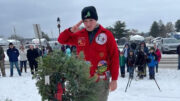When considering starting your plants from seed, it is useful to know what information is found on the seed packet.
When deciding what to plant this year, consider starting your plants from seed. Seeds offer a low-cost opportunity to establish old favorites and try out new cultivars. In addition, there are typically more plant options when using seeds than purchasing plants. When considering seeds, it is useful to know what information is found on the seed packet.
- Picture – A picture of the plant in flower or harvested fruit or vegetable is generally found on the front of the seed packet. It can be used to determine flower type and color and what to expect when harvesting the fruit or vegetable. Remember that the picture is representative of the flower, fruit, or vegetable at its best, so use it only as a guide.
- Plant Description – Seed packets usually provide a written description of the plant including common and scientific names, plant height at maturity, days to harvest or bloom and habit – i.e. climbing, upright, etc.
- Uses and Weight – Seed packets often contain suggested uses for the plant such as in containers, in beds, as winter houseplants, for trellises, etc. The number or weight of the seeds is also found on the packet, which is useful in determining the number of packets needed.
- Date – The year that the seeds were packaged, for example, “Packed For Season 2002,” is also found on the packet. This information is important because as seeds age, their viability decreases, which means that fewer seeds will germinate in subsequent years. If seeds have a germination rate of 80 percent in 2002, the 2003 rate can be expected to be lower, for example, 50 percent.
- Planting Directions – Seed packets should state when to plant the seeds depending on which region in the United States they will be sown. Directions should include planting depth, spacing, light exposure requirements, whether or not the seeds should be planted indoors prior to planting outdoors, and basic directions for the care of the plant.
Some seed packets contain additional information
- Perennials – The cold hardiness zone, based on the lowest temperature the plant will survive in, will be found on the back of the packet. Since cold hardiness zones in Pennsylvania range from 4 to 7, it is important to know in which zone the seeds will be sown. This information is sometimes included on the seed packet, and it can also be found in gardening books.
- Seed Mixes – Typical packaged seed mixes include: wildflowers, gourds, and salad mixes. Additional information on these seed packets is the percentage of each seed type, the area the seeds will cover, the life cycle of the plants, i.e. annual, biennial, or perennial, and the percentage inert matter or vermiculite. Inert matter and vermiculite are included to help in broadcast the seed uniformly.
- It is a good idea to keep the seed package after sowing as a reference for future care and harvesting. The diversity of seeds offered can be exciting because of the limitless planting combinations of flowers, fruit, and vegetables to grow and enjoy.
The article above was prepared by Elsa S. Sánchez, assistant professor of horticultural systems management. This educational blog is a series of informative articles from the Penn State Master Gardeners volunteers plus news concerning the group and their activities. For more information, click here.


































